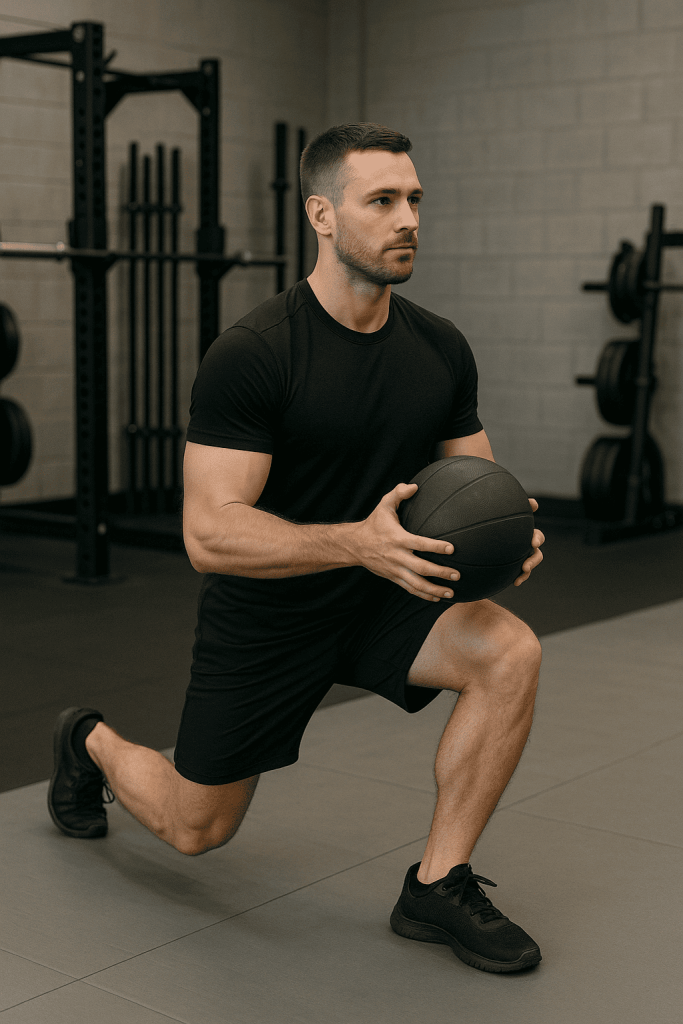15 de May de 2025
Med Ball Lunges: Exercise Guide, Tips and Benefits
Medicine ball lunges are a dynamic full-body movement that combines lower-body strength training with core activation and coordination. By adding a med ball to your lunges—whether held at chest level, overhead, or with rotation—you increase instability, demand better control, and intensify the challenge for both muscles and mind. They’re a great choice for athletes, fitness enthusiasts, and anyone looking to add variety to their training.
What Are Med Ball Lunges?
Med ball lunges are traditional forward, backward, or walking lunges performed while holding a medicine ball. The added load and potential for movement (e.g., rotation or overhead pressing) makes this a multi-joint, compound exercise that targets both stability and strength. They’re used in functional training, strength and conditioning, and even rehab settings to enhance balance, coordination, and muscular endurance.
How to Do Med Ball Lunges Properly
- Stand tall: Hold a medicine ball at chest height with both hands.
- Step forward: Take a long step with your lead leg and lower into a 90° bend in both knees.
- Keep your chest up: Maintain a tall spine and brace your core.
- Return to start: Drive through the front heel to return to standing.
- Repeat on the other side.
Common variations include:
- Holding the ball overhead for shoulder engagement.
- Rotating the torso toward the lead leg to activate obliques.
- Performing walking or reverse lunges for variety.
Tip: Keep the front knee aligned with the toes and avoid leaning too far forward.
Muscles Worked by Med Ball Lunges
Med ball lunges engage multiple muscle groups simultaneously:
- Quadriceps and hamstrings: Primary movers during descent and ascent.
- Glutes: Drive hip extension and support posture.
- Calves: Stabilize the lower leg.
- Core and obliques: Activate to stabilize the torso, especially with rotation.
- Shoulders and arms: Engaged when the med ball is held or moved.

Benefits of Med Ball Lunges
- Improved Balance and Coordination: The shifting load trains proprioception and control.
- Enhanced Core Engagement: The med ball forces abdominal activation.
- Total Body Conditioning: Effective for strength and cardio when performed in circuits.
- Versatile for All Levels: Easy to scale with ball weight, reps, and variations.
- Fatigue Management: A powerful tool to challenge the body without overloading the spine, helping regulate fatigue.
Common Mistakes to Avoid
- Allowing the Knee to Collapse: Keep knees tracking over the toes.
- Rushing the Movement: Move with control to maintain balance and form.
- Overextending the Back: Keep your core engaged to avoid lumbar strain.
- Holding the Ball Too Low: Maintain tension by keeping the ball active—at chest level or higher.
Variations of Med Ball Lunges
- Med Ball Rotational Lunge: Rotate the torso toward the lead leg.
- Overhead Med Ball Lunge: Hold the ball overhead for shoulder stability and mobility.
- Walking Lunge with Pass: Pass the ball under your front leg between steps.
- Reverse Lunge to Press: Add an overhead press at the top of each rep.
How to Include Med Ball Lunges in Your S&C Workout
Include them in full-body circuits, warm-ups, or unilateral strength days. Perform 2–4 sets of 8–12 reps per side. They work well as a superset with upper body or core work and are a great substitute for barbell lunges when managing joint stress or fatigue. Pair with mobility drills to support safe and effective movement patterns.

FAQs About Med Ball Lunges
Are walking lunges bad for the knees?
Not when done with proper form—keep your knees aligned, core engaged, and avoid stepping too short or collapsing forward.
Do lunges reduce belly fat?
Lunges help build muscle and burn calories, but reducing belly fat also requires a calorie deficit and consistent full-body training.
What type of lunge is best for knees?
Reverse lunges are often gentler on the knees than forward lunges due to less forward momentum and joint stress.
Are lunges better for you than squats?
Both are valuable—lunges emphasize unilateral strength and balance, while squats are better for maximal strength and power.
What are the benefits of lunges with medicine ball?
They boost core activation, challenge coordination, and allow for more dynamic variations in your lower-body training.
How to do lunges with a medicine ball?
Hold the ball at chest or overhead, step into a lunge, maintain posture and balance, then push back to the starting position with control.
Med ball lunges are a smart, scalable way to train strength, stability, and athletic coordination. Whether you’re rotating, pressing, or simply holding the ball, they add functional intensity to your strength and conditioning routine—while helping you manage fatigue and improve full-body movement quality.
